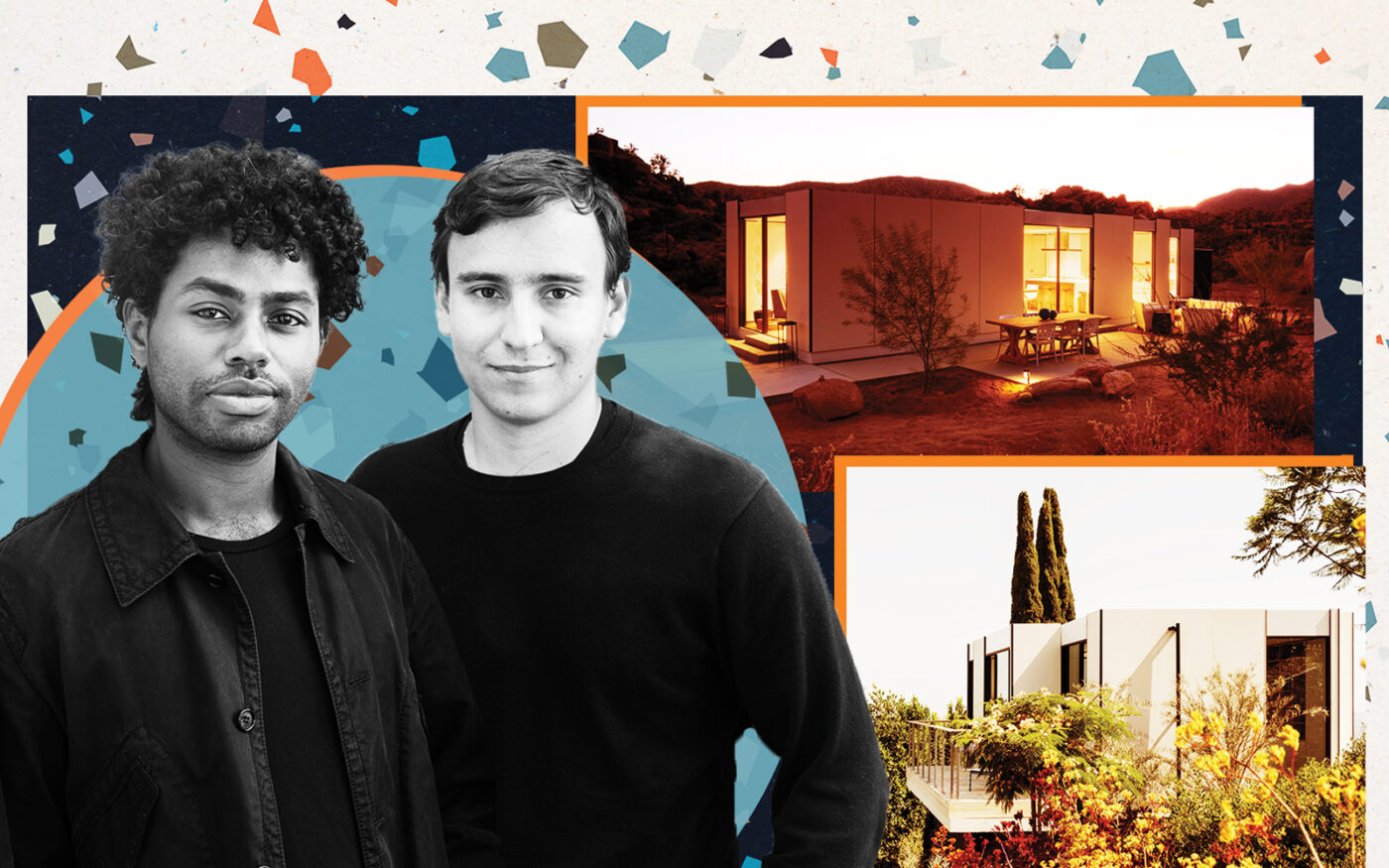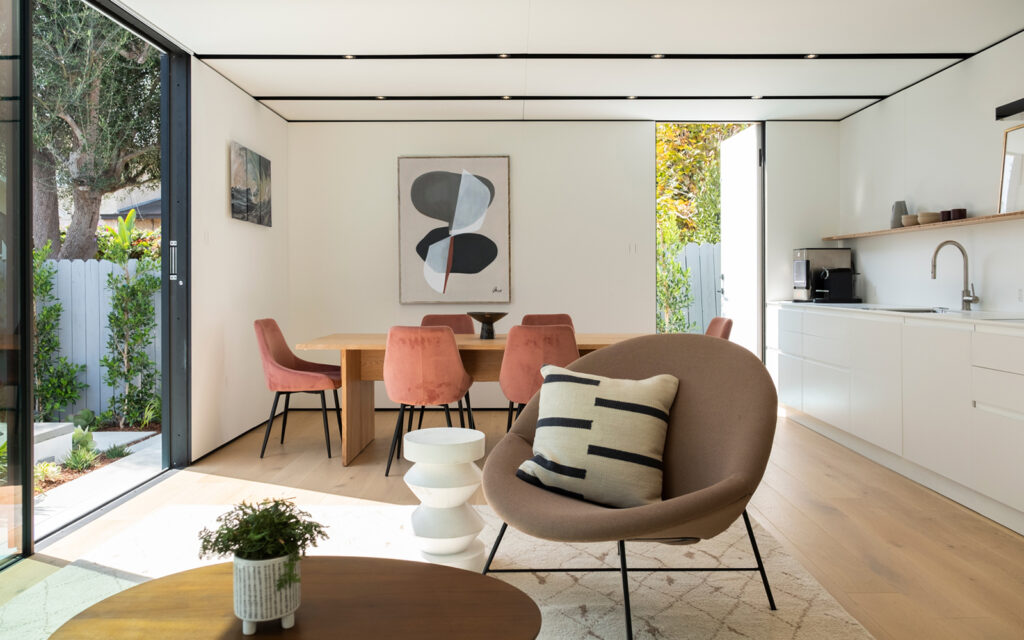Trending
Homebuilding startup Cover: Big dreams, small realities
The custom backyard homebuilder has raised $75M with hopes to dent the affordability crisis. It's been slow going so far.

When Alexis Rivas, co-founder and CEO of homebuilding startup Cover, talks about his firm on social media, he’s liable to place it in exalted company. Cover is the Tesla of homebuilding, the Apple of homes, and Rivas is Henry Ford, or maybe Ray and Charles Eames.
His vision: build high-end, thoughtfully designed, panelized homes, fabricating and assembling Lego-like pieces in a factory. The intended result is a fast, green, cost-effective and ultimately revolutionary shift in homebuilding. Venture capital giant Andreessen Horowitz put Cover on its list of 50 firms it claims are “kickstarting American renewal” by tackling the nation’s hairiest problems.
Sticking to the Tesla comparison, Rivas said in a recent phone interview that Cover has hit its Roadster phase, a reference to the automaker’s first-generation electric sports car. Currently Cover is focused on delivering high-end backyard homes to the Los Angeles market.
But since its founding in 2014, Cover, which has raised $75 million from investors with a $180 million valuation, can’t say that its output has equaled those of its prodigious idols. An analysis of previous statements from Rivas and building permits suggests the firm has only completed between 30 and 40 ADUs in its nine years of existence — that’s an average of under 5 homes per year, which would be a miniscule amount for an ADU developer, much less a firm trying to revolutionize construction.
Rivas acknowledged that the firm has finished just a “few dozen” backyard dwellings. Nobody at Cover would discuss revenue, profitability timelines, strategies, or even how the startup determines success.
“I’m not going to share the exact metrics, but we have very specific internal metrics that are ambitious,” Rivas said.
Cover says it will eventually scale to homes and apartments and start producing hundreds and even thousands of units once it masters its manufacturing process.
“Start with a high-end product that works phenomenally well, way better than anything that has come before it,” Rivas added. “And then as you invest in production and scale, you lower the cost and make it available to everyone.”
Trust the process
The story, Rivas says, isn’t in units built. It’s in the process now being figured out in Cover’s 80,000-square-foot factory in Southern California, which Rivas says will change homebuilding forever. And right now, he says, things are going “phenomenally well.”
(Cover declined a request for a factory tour for this story, saying there wasn’t enough time to arrange one during the reporting, but you can catch a few glimpses of the workspace on some YouTube videos from tech evangelists.)
Installing a unit, which comprises 10,000 parts and took 120 days and about a dozen people three years ago, has dropped to 30 days and six people. Rivas is aiming for costs of $200 per square foot. Right now, Cover’s modular ADUs go for between $400 and $600 per square foot, but when the startup moves beyond ADUs, Rivas claims that will drop considerably. He also said his existing clients were happy with paying a 20 to 30 percent premium to choose Cover and get “world-class architecture,” summing it up by asking, “Do you want a Porsche, or do you want a Toyota?”
“I’m not going to share the exact metrics,
but we have very specific internal metrics that are ambitious.”
They’re certainly paying Porsche prices. Cover previously listed a 450-square-foot, one-bedroom unit on its website for $241,000, or $535 a square foot (this doesn’t include costs for permitting, engineering or sitework). Rivas explained that every design is custom, but most one-bedrooms now range from $295,000 to $325,000. (As he’s also explained, current costs represent an increase from past pricing, but buyers “can’t get comparable quality products at this price.”)
Prices for other prefab or modular ADUs on the market vary: A 600-square-foot, one-bedroom ADU from competitor Oasys runs roughly $240,000, or $400 per square foot, and a 640-square-foot Connect 2 series model by Connect Homes runs $307,800, or $480 per foot.
Unlike other prefab firms, Cover’s units will be built in a factory, a kit-of-parts system easy to assemble on-site and transport with standard-sized trucks. And unlike Katerra, the unicorn modular firm that famously crashed and burned in 2021 as it tried to rapidly grow and expand, Cover clearly doesn’t want to rush.
“Nail it before you scale it” is the motto, with roughly three-fourths of the company’s time spent on process refinements, not deliveries.
During a tour of a Cover unit on a hilly side street in L.A.’s Silver Lake neighborhood, Cover’s other co-founder, Jemuel Joseph, explained how the sleek, wood-paneled unit came to be. A grid of slats, made from high-density composite and coated with white house paint, were shipped in sequence to the site, a hilly lot atop an existing garage, and then installed. Boasting an expensive Wolf range and Sub-Zero fridge, copious built-in storage, pale wood floors, electromagnetic locks and custom panels for switches and plugs, the space did have the trappings of a high-end home.
Joseph said it took 33 days to put the building together, a roughly 450-square-foot ADU that cost around $300,000, or $666/SF. Cover also offers copious documentation for simple repairs. It has certainly evolved; in 2016, Rivas spoke of “unique, highly tailored, precision-built homes,” and in 2017 it was claimed that Cover’s structures met passive house standards (they currently do not, though Rivas does hype their sustainability).
The model we were in, a few years old at this point, had placed the single HVAC unit in a built-in cabinet in the main room, which meant that when the door to the bedroom was shut, it wouldn’t get direct air conditioning. That issue has been fixed in later versions. While standing on the patio, Joseph followed up a remark about a wall assembly by saying that even the screws being used to put the place together could be improved upon in pursuit of a more seamless product.
“Nobody is building homes like cars,” he said.
That’s why the Cover factory right now has low automation and low production volume, which the company says makes it easier for the team of 25-plus architects and engineers to improve and iterate. This approach isn’t a problem for Stephen Oskoui, managing partner at Gigafund, the venture capital firm which led Cover’s $60 million Series B investment round during the startup fundraising frenzy in 2021.
Cover’s strategy of perfecting manufacturing before scaling fits Gigafund’s premise, investing in startups with multi-decade roadmaps to solving big problems. Oskoui wasn’t willing to explain or detail any of the milestones used to measure Cover’s progress, but he said they’re on track, and can see them building 1 million units a year by the end of Gigafund’s 20-year investment window. (Again, Cover is averaging a little over four ADUs a year right now.)
Oskoui believes that, like Apple and Tesla, if you’re investing in mass manufacturing, you need to invest in phenomenal product design.
“There are ways they could have scaled up much faster to appeal to investors, but wouldn’t have set them up for long-term success,” said Oskoui. “We like the fact that they ignored the noise of a frothy Silicon Valley environment.”

First principles
Many VCs see transformative potential in modular housing. Clay Macfarlane, a principal at Fifth Wall, a proptech-focused VC with multiple modular investments, said the tailwinds seem promising: Housing is unaffordable and hard to find. The national housing shortage grew to an estimated 6.5 million units as of the end of 2022. Macfarlane admitted that there are still regulatory and political obstacles to speeding up housing construction — the best technology can’t change zoning laws — but even if those impediments remain, speeding up construction once permitting is finished and shrinking carrying costs will lower the price of housing.
Rivas said the success Cover has had comes from his and Joseph’s focus on being “first principles thinkers,” a process that refers to the idea of breaking down problems into their most elemental parts and rebuilding a solution from there. (“First principles thinking” is a favorite mantra among the startup set, from Elon Musk to Peter Thiel.)
Cover’s founders met in New York City while enrolled in Cooper Union’s highly selective architecture school. They were both fascinated by technology’s potential to upend the discipline, and eventually arrived at the idea of rapid iteration. It’s easier to continually tweak a small ADU than a full-fledged home, a decision Cover made months before California began passing laws to encourage ADU production.
There’s also belief in tech’s hard-work-and-hustle mentality. Last month, Rivas responded to a viral Bernie Sanders tweet calling for a 32-hour work week by writing, “That sounds really stressful. I’m less stressed when I work 60+ hours a week.”
Cover’s vision of panelized construction and Lego-like pieces that can fit onto standard trucks, aligns with general trends in the prefab construction industry. The idea of solving America’s housing crisis with factory-built homes has been around since the early 20th century, and a crop of startups about a decade ago ran aground over common impediments: challenges with affordably scaling factory production, and the cost and complexity of moving prebuilt homes and modules on-site (which typically required expensive cranes and lengthy permitting processes).
Fifth Wall’s Macfarlane said the key to modular success — producing an incremental unit at a profitable margin — was never achieved by this previous generation of startups. Factories were more expensive and output was limited, stretching the payback period beyond viability. Today, factories are cheaper and easier to build, in part due to advances in technology, and it should be easier to build up a network and scale.
Steve Glenn, CEO of modular home builder Plant Prefab — where Rivas worked briefly when it was still called LivingHomes — described the future Cover CEO as “one of the brightest interns that we had.”
LivingHomes’ successor, Plant, has since been around for seven years and has built 150 single- and multifamily housing units. Glenn sees the Apple and Tesla comparison as slightly misleading. Manufacturing a computer or car means abiding by strict standards for a national and international customer base. Homebuilding means dealing with local regulations, zoning requirements and changing soils and site conditions — jurisdiction by jurisdiction and lot by lot.
When asked about expansion plans, Gigafund’s Oskoui, after a lengthy pause, said he’s eager to see them expand to Texas as soon as possible, because he would like his own Cover units. But he doesn’t see them expanding outside L.A. until they build their “very big factory” and scale up production (he confirmed plans for a new site other than the current Gardena, California, location).
Asked if the firm is seeking new funding soon, Rivas said Cover is “fortunately in a very good place as far as our funding situation,” but will eventually need more money to meet its grand ambitions.
There’s also a continued challenge around who, exactly, Cover’s future customers will be.
Rivas has talked about tackling the affordable housing challenge with this technology (which, perhaps, won’t include Sub-Zero kitchen appliances). But the constant comparisons to Apple and Tesla — brands with mass success and sales figures, even though their products are not exactly targeting the low-income market — belies something different.
At the end of the tour, after staring at the L.A. landscape from the unit’s patio, Joseph explained the origin of the firm’s name: Cover is the most basic kind of habitat.
“I suppose,” he said, “we want to cover humanity.”




